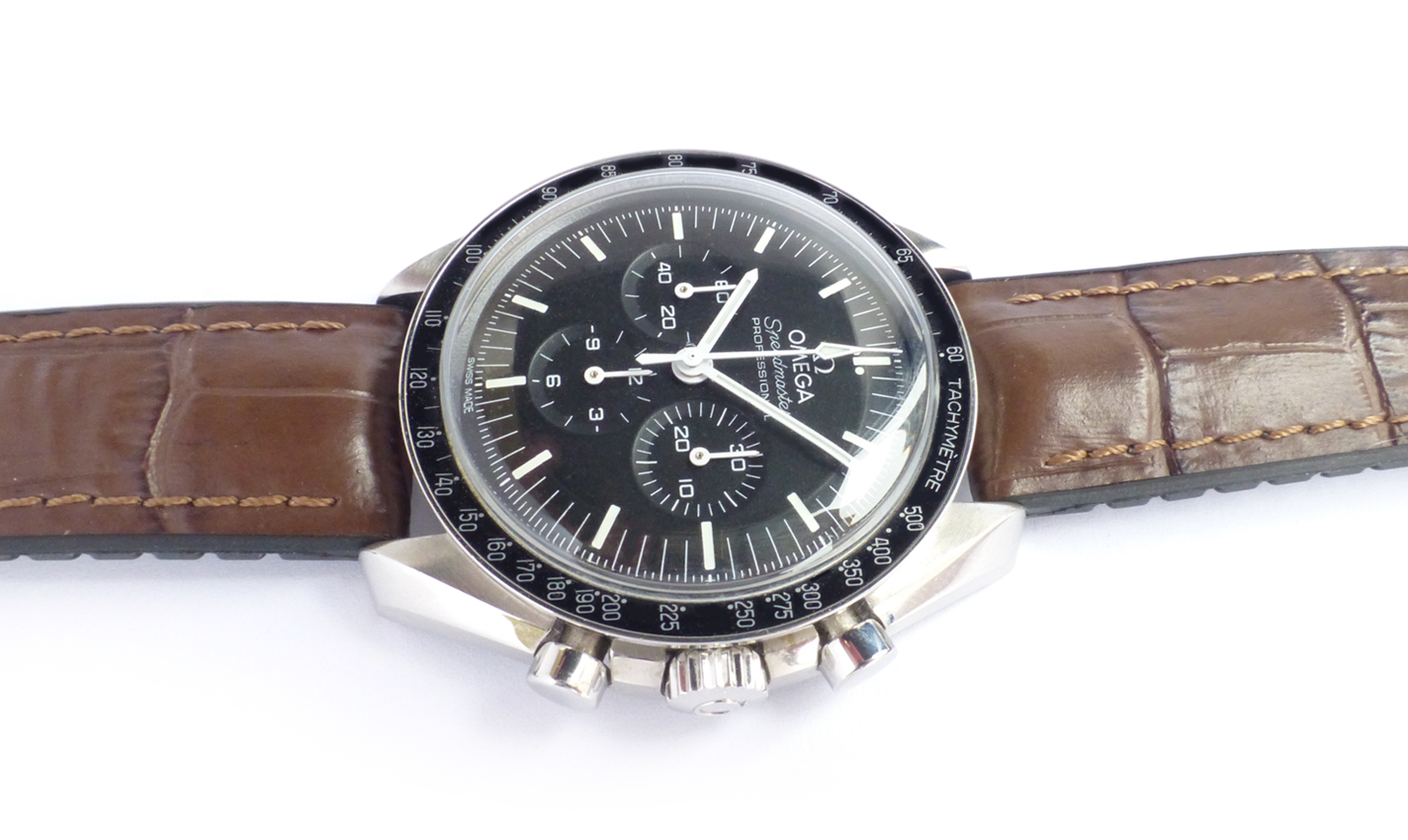Omega Omega Speedmaster Moonwatch Professional NWW 2137
Omega Speedmaster Moonwatch Professional
Omega Speedmaster Moonwatch dating to 2022, complete with box and papers. It is the latest model with the new movement and the UK retail price is £6200. Model reference 310.32.42.50.01.001. It comes on the original black strap which looks un worn condition as it has been worn on replacement brown Hirsch leather strap which comes with the watch. The Speedmaster is one of the world’s most iconic timepieces. Having been a part of all six moon landings, the legendary chronograph is an impressive representation of the brand’s adventurous pioneering spirit. Presented on a nylon fabric strap, this 42 mm Moonwatch in stainless steel features hesalite glass on the front and an embossed Seahorse medallion on the caseback. Inspired by the 4th generation Speedmaster style worn on the moon, it also includes an asymmetrical case, black step dial and the famous dot over 90 on the anodised aluminium bezel ring.
The watch is driven by the OMEGA Co-Axial Master Chronometer Calibre 3861, which powers the small seconds sub-dial, 30-minute recorder and 12-hour recorder, along with the central chronograph function.
MOVEMENT
Calibre: Omega 3861 Manual-winding chronograph movement with Co-Axial escapement
Certified Master Chronometer
Approved by METAS
Resistant to magnetic fields reaching 15,000 gauss
Free-sprung balance with silicon balance spring
Rhodium-plated finish, bridges with straight Geneva waves
Power reserve: 50 hours
CRYSTAL
Hesalite (acrylic) crystal with OMEGA logo in the centre
WATER RESISTANCE
5 bar (50 metres / 167 feet)
WATCH CASE & DIAL
Case: Steel Case
Diameter: 42 mm
Between lugs: 20 mm
Dial Colour: Black
BRACELET
Material: Coated nylon fabric strap
Strap colour: Black
Buckle type: Foldover clasp
Buckle material: Stainless steel
Key Characteristics
Additional Product Details
Omega Watches. Founded at La Chaux-de-Fonds, Switzerland in 1848 by 23-year-old Louis Brandt who assembled key-wound precision pocket watches from parts supplied by local craftsmen. He travelled throughout Europe selling his watches from Italy to Scandinavia by way of England, his chief market. After Louis Brandt's death in 1879, his two sons Louis-Paul and Cesar, troubled by irregular deliveries of questionable quality, abandoned the unsatisfactory assembly workshop system in favour of in-house manufacturing and total production control. Due to the greater supply of manpower, communications and energy in Bienne, the enterprise moved into a small factory in January 1880, then bought the entire building in December. Two years later the company moved into a converted spinning-factory in the Gurzelen district of Bienne, where headquarters are still situated today. Their first series-produced calibres, Labrador and Gurzelen, as well as, the famous Omega calibre of 1894, would ensure the brand's marketing success. Louis-Paul and Cesar Brandt both died in 1903, leaving one of Switzerland's largest watch companies - with 240,000 watches produced annually and employing 800 people - in the hands of four young people, the oldest of whom, Paul-Emile Brandt, was not yet 24. Considered to be the great architect and builder of OMEGA, Paul-Emile's influence would be felt over the next half-century. The economic difficulties brought on by the First World War would lead him to work actively from 1925 toward the union of OMEGA and Tissot, then to their merger in 1930 within the group SSIH, Geneva. Under his leadership, then that of Joseph Reiser beginning in 1955, the SSIH Group continued to grow and multiply, absorbing or creating some fifty companies. By the seventies, SSIH had become Switzerland's number one producer of finished watches and number three in the world. Weakened by the severe monetary crisis and recession of 1975 to 1980, SSIH was bailed out by the banks in 1981. Switzerland's other watchmaking giant ASUAG, principal producer of movement blanks and owner of the Longines, Rado and Swatch brands, was saved in similar fashion one year later. After drastic financial cleansing and a restructuring of the two groups' R&D and production operations at the ETA complex in Granges, the two giants merged in 1983 to form the Holding ASUAG-SSIH. In 1985 the holding company was taken over by a group of private investors under the strategy and leadership of Nicolas Hayek. Immediately renamed SMH, Société suisse de Microélectronique et d'Horlogerie, the new group achieved rapid growth and success to become today's top watch producer in the world. Named Swatch Group in 1998, it now includes Blancpain and Breguet. Dynamic and flourishing, OMEGA remains one of its most prestigious flagship brands











